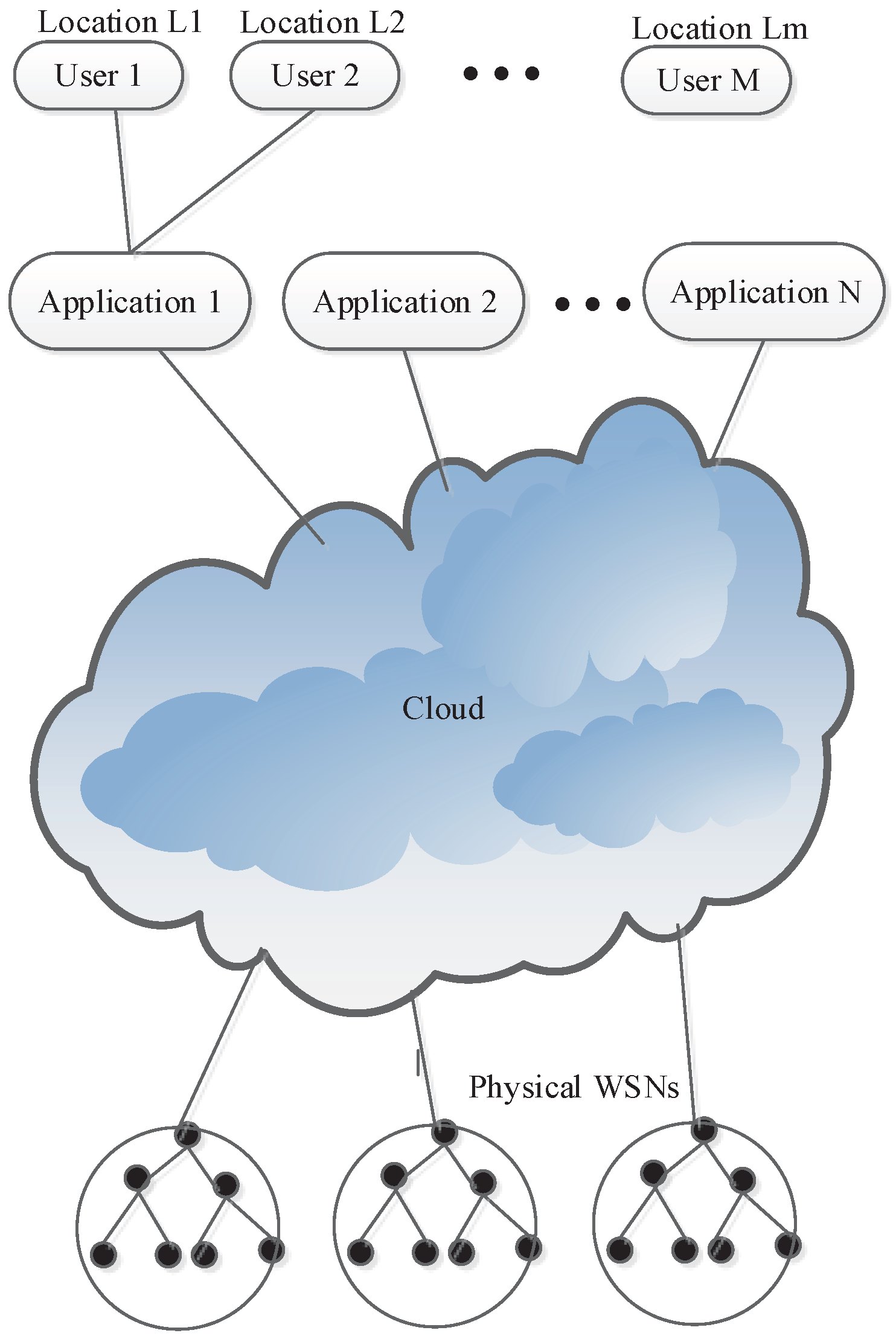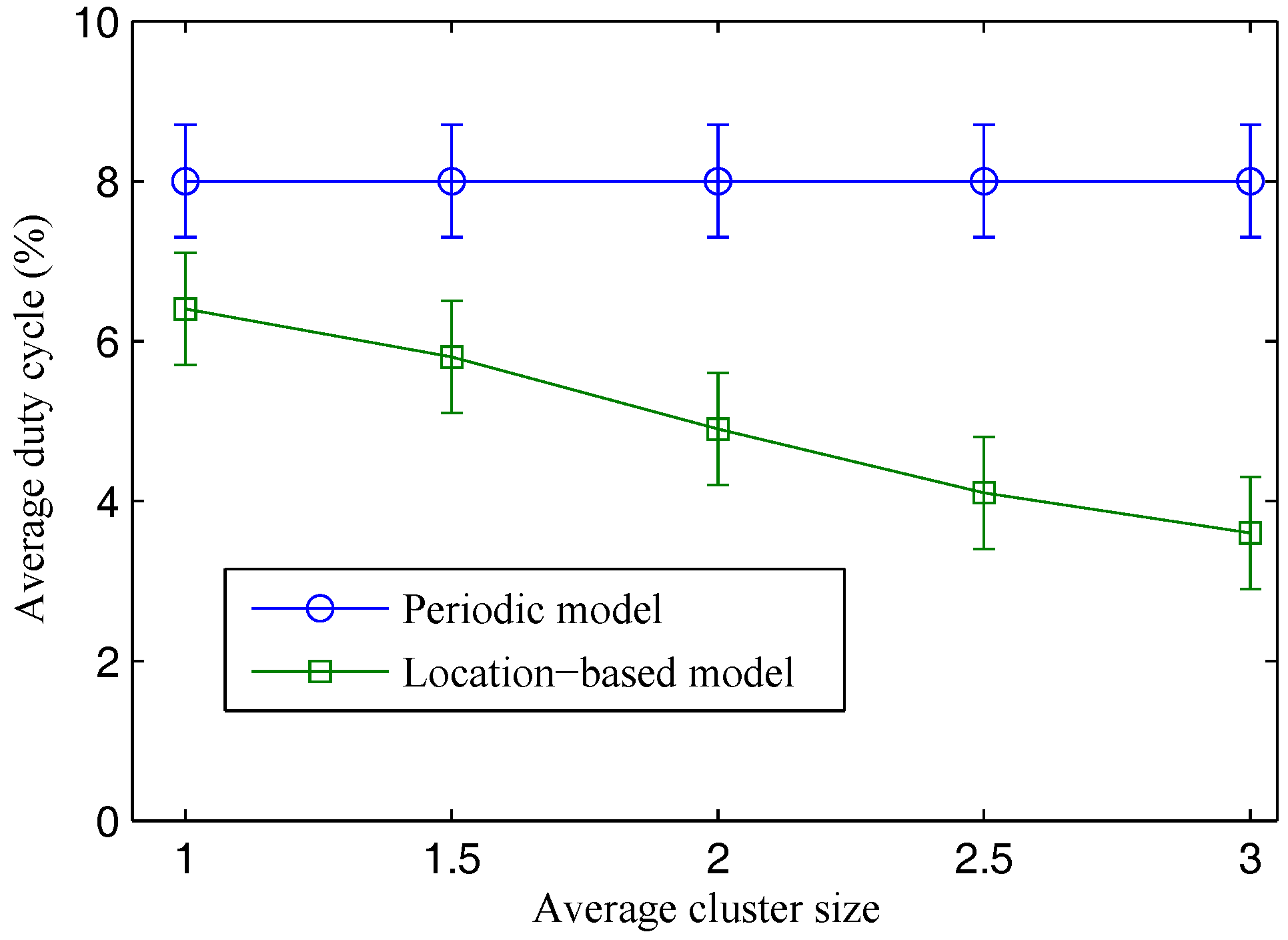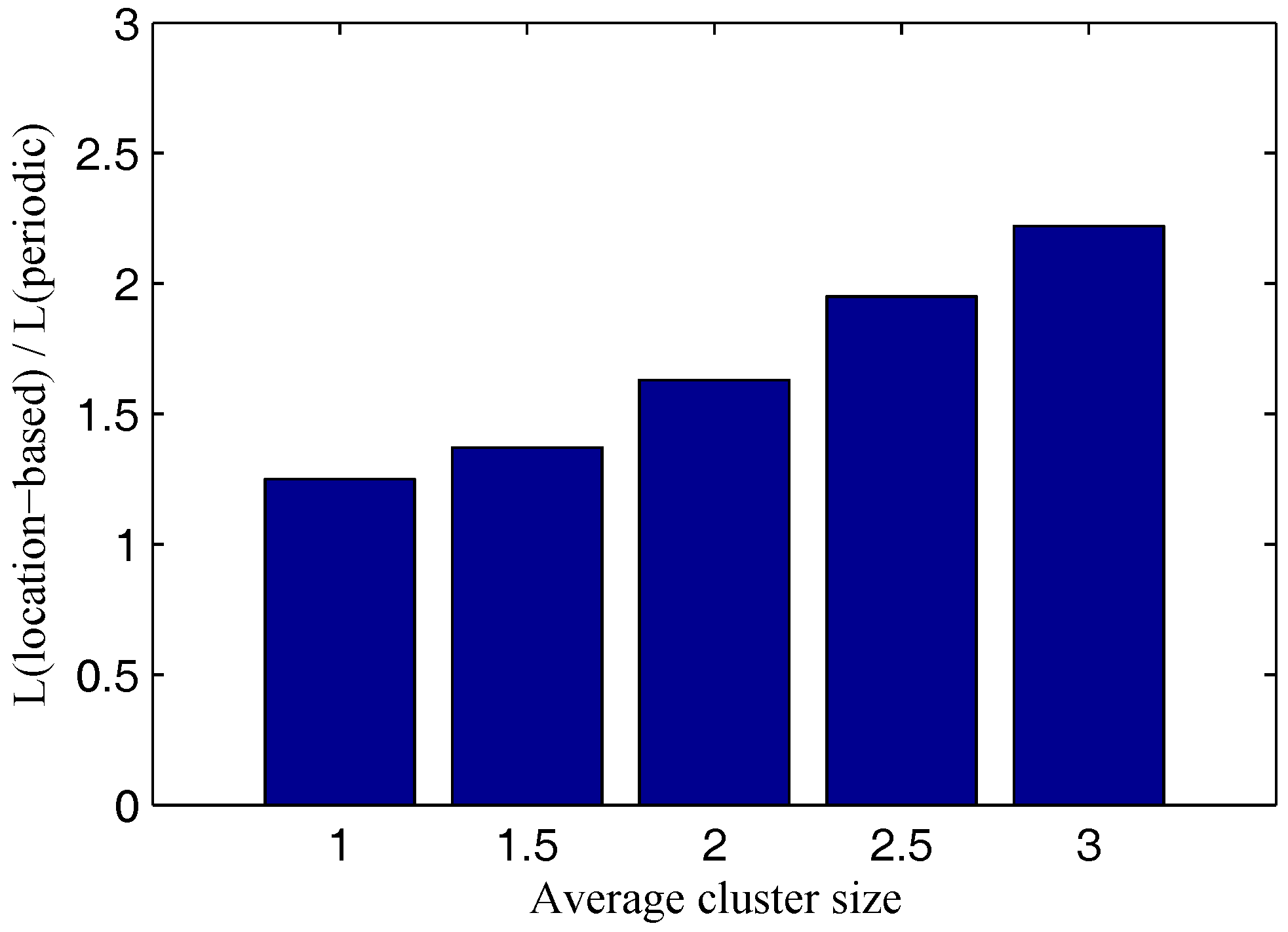A Location-Based Interactive Model of Internet of Things and Cloud (IoT-Cloud) for Mobile Cloud Computing Applications
Abstract
:1. Introduction
- We model a location-based interactive approach for IoT-cloud to served mobile cloud computing applications;
- We present an on-demand scheduling scheme for WSNs on the top of the model. In the scheme, the cloud plays a role as a controller that schedules sensing operations of WSNs based on mobile users’ location on demand;
- Through comprehensive analysis and experiments, we show that the location-based model achieves a significant improvement in terms of energy efficiency and network lifetime compared to the periodic sensing model.
2. Related Work
3. The Location-Based Interactive Model
3.1. Entities
3.2. Mapping Functions
3.3. Periodic Sensing Model
3.4. Location-Based On-Demand Sensing Model
| Algorithm 1 On demand location-based scheduling scheme for WSNs |
| Step 1: cloud current location of mobile user μ Step 2: cloud allocates a set of virtual sensors and reversely map to a set of physical sensor nodes which matches with interest of the application and the user, using the above functions Step 3: cloud makes a schedule for the sensor nodes based on current location and requirements of the mobile user Step 5: cloud sends a scheduling request to a corresponding base station Step 6: broadcasts the scheduling request to corresponding sensors. Step 7: nodes that receive the scheduling request set their own schedule based on the request. Step 8: when the user moves out of the area, cloud c sends a request to cancel the scheduling request for the set of sensors. |
3.4.1. Selective Nodes for Transmission
3.4.2. Multiple Mobile Users within a Geographical Region
4. Performance Evaluation
4.1. Performance Analysis
4.2. Numerical Results
5. Conclusions
Acknowledgments
Author Contributions
Conflicts of Interest
References
- Babu, S.; Lakshmi, A.; Rao, B. A study on cloud based Internet of Things: CloudIoT. In Proceedings of the Global Conference on Communication Technologies (GCCT), Thuckalay, India, 23–24 April 2015; pp. 60–65.
- Fazio, M.; Puliafito, A. Cloud4sens: A cloud-based architecture for sensor controlling and monitoring. IEEE Commun. Mag. 2015, 53, 41–47. [Google Scholar] [CrossRef]
- Dinh, T.; Kim, Y. An Efficient Interactive Model for On-Demand Sensing-As-A-Services of Sensor-Cloud. Sensors 2016, 16, 992. [Google Scholar] [CrossRef] [PubMed]
- Dinh, T.; Kim, Y.; Lee, H. A location-based interactive model for Internet of Things and cloud (IoT-cloud). In Proceedings of the Eighth International Conference on Ubiquitous and Future Networks (ICUFN), Vienna, Austria, 5–8 July 2016; pp. 444–447.
- Madria, S.; Kumar, V.; Dalvi, R. Sensor Cloud: A Cloud of Virtual Sensors. IEEE Softw. 2014, 31, 70–77. [Google Scholar] [CrossRef]
- Santos, I.; Pirmez, L.; Delicato, F.; Khan, S.; Zomaya, A. Olympus: The Cloud of Sensors. IEEE Cloud Comput. 2015, 2, 48–56. [Google Scholar] [CrossRef]
- Sheng, Z.; Wang, H.; Yin, C.; Hu, X.; Yang, S.; Leung, V. Lightweight Management of Resource-Constrained Sensor Devices in Internet of Things. IEEE Internet Things J. 2015, 2, 402–411. [Google Scholar] [CrossRef]
- Chatterjee, S.; Misra, S. Optimal composition of a virtual sensor for efficient virtualization within sensor-cloud. In Proceedings of the IEEE International Conference on Communications (ICC), London, UK, 8–12 June 2015; pp. 448–453.
- Chatterjee, S.; Ladia, R.; Misra, S. Dynamic Optimal Pricing for Heterogeneous Service-Oriented Architecture of Sensor-cloud Infrastructure. IEEE Trans. Serv. Comput. 2015. [Google Scholar] [CrossRef]
- Misra, S.; Bera, S.; Mondal, A.; Tirkey, R.; Chao, H.C.; Chattopadhyay, S. Optimal gateway selection in sensor-cloud framework for health monitoring. IET Wirel. Sens. Syst. 2014, 4, 61–68. [Google Scholar] [CrossRef]
- Chatterjee, S.; Sarkar, S.; Misra, S. Energy-efficient data transmission in sensor-cloud. In Proceedings of the Applications and Innovations in Mobile Computing (AIMoC), Kolkata, India, 12–14 February 2015; pp. 68–73.
- Chatterjee, S.; Misra, S. Dynamic and adaptive data caching mechanism for virtualization within sensor-cloud. In Proceedings of the IEEE International Conference on Advanced Networks and Telecommuncations Systems (ANTS), New Delhi, India, 14–17 December 2014; pp. 1–6.
- Dinh, T.; Gu, T.; Vasilakos, A.; Kim, Y. L-MAC: A Wake-up Time Self-learning MAC Protocol for Wireless Sensor. Comput. Netw. 2016, 105, 33–46. [Google Scholar]
- Bhattacharya, S.; Blunck, H.; Kjærgaard, M.B.; Nurmi, P. Robust and Energy-Efficient Trajectory Tracking for Mobile Devices. IEEE Trans. Mob. Comput. 2015, 14, 430–443. [Google Scholar] [CrossRef]
- Zhuang, Z.; Kim, K.H.; Singh, J.P. Improving Energy Efficiency of Location Sensing on Smartphones. In Proceedings of the 8th International Conference on Mobile Systems, Applications, and Services (MobiSys ’10), San Francisco, CA, USA, 15–18 June 2010; pp. 315–330.
- Ananthanarayanan, G.; Haridasan, M.; Mohomed, I.; Terry, D.; Thekkath, C.A. StarTrack: A Framework for Enabling Track-based Applications. In Proceedings of the 7th International Conference on Mobile Systems, Applications, and Services (MobiSys ’09), Krakow, Poland, 22–25 June 2009; pp. 207–220.
- Lee, J.; Park, H.; Kang, S.; Kim, K.I. Region-Based Collision Avoidance Beaconless Geographic Routing Protocol in Wireless Sensor Networks. Sensors 2015, 15, 13222–13241. [Google Scholar] [CrossRef] [PubMed]
- Saad, C.; Benslimane, A.; Champ, J.; Konig, J.C. Ellipse Routing: A Geographic Routing Protocol for Mobile Sensor Networks with Uncertain Positions. In Proceedings of the 2008 IEEE Global Telecommunications Conference, New Orleans, LA, USA, 30 November–4 December 2008; pp. 1–5.
- Zhang, H.; Shen, H. Energy-Efficient Beaconless Geographic Routing in Wireless Sensor Networks. IEEE Trans. Parallel Distrib. Syst. 2010, 21, 881–896. [Google Scholar] [CrossRef]
- Fortunato, S. Community detection in graphs. Phys. Rep. 2010, 486, 75–174. [Google Scholar] [CrossRef]
- Tibshirani, R. Regression Shrinkage and Selection via the Lasso. J. R. Stat. Soc. Ser. B Methodol. 1996, 58, 267–288. [Google Scholar]
- Kim, B.; Lee, S.; Lee, Y.; Hwang, I.; Rhee, Y.; Song, J. Mobiiscape: Middleware support for scalable mobility pattern monitoring of moving objects in a large-scale city. J. Syst. Softw. 2011, 84, 1852–1870. [Google Scholar] [CrossRef]
- Bhargava, P.; Gramsky, N.; Agrawala, A. SenseMe: A System for Continuous, On-device, and Multi-dimensional Context and Activity Recognition. In Proceedings of the 11th International Conference on Mobile and Ubiquitous Systems: Computing, Networking and Services (MOBIQUITOUS ’14), London, UK, 2–5 December 2014; pp. 40–49.
- Fernandez, C.; Dominguez, R.; Fernandez-Llorca, D.; Alonso, J.; Sotelo, M.A. Autonomous Navigation and Obstacle Avoidance of a Micro-Bus. Int. J. Adv. Robot. Syst. 2013, 10, 212. [Google Scholar] [CrossRef]
- Luettel, T.; Himmelsbach, M.; Wuensche, H.J. Autonomous Ground Vehicles—Concepts and a Path to the Future. Proc. IEEE 2012, 100, 1831–1839. [Google Scholar] [CrossRef]
- GPS Accuracy. Available online: http://www.gps.gov/systems/gps/performance/accuracy/ (accessed on 27 February 2017).





| Parameter | Value | Parameter | Value |
|---|---|---|---|
| Data packet length | 32 bytes | Nodes | 100 |
| Carrier sensing | 2.5 ms | Sensing | 2 ms |
| 0.5 s | 10 s | ||
| 0.25 s | 1 s | ||
| 1 s | ∞ | ||
| Θ | 1–5 | # of apps | 1–5 |
| 10 s–10 min | 4 s | ||
| h | 5 | # of nodes | 126 |
| ρ | 0.5 | /byte | 0.032 ms |
© 2017 by the authors. Licensee MDPI, Basel, Switzerland. This article is an open access article distributed under the terms and conditions of the Creative Commons Attribution (CC BY) license ( http://creativecommons.org/licenses/by/4.0/).
Share and Cite
Dinh, T.; Kim, Y.; Lee, H. A Location-Based Interactive Model of Internet of Things and Cloud (IoT-Cloud) for Mobile Cloud Computing Applications. Sensors 2017, 17, 489. https://doi.org/10.3390/s17030489
Dinh T, Kim Y, Lee H. A Location-Based Interactive Model of Internet of Things and Cloud (IoT-Cloud) for Mobile Cloud Computing Applications. Sensors. 2017; 17(3):489. https://doi.org/10.3390/s17030489
Chicago/Turabian StyleDinh, Thanh, Younghan Kim, and Hyukjoon Lee. 2017. "A Location-Based Interactive Model of Internet of Things and Cloud (IoT-Cloud) for Mobile Cloud Computing Applications" Sensors 17, no. 3: 489. https://doi.org/10.3390/s17030489
APA StyleDinh, T., Kim, Y., & Lee, H. (2017). A Location-Based Interactive Model of Internet of Things and Cloud (IoT-Cloud) for Mobile Cloud Computing Applications. Sensors, 17(3), 489. https://doi.org/10.3390/s17030489





